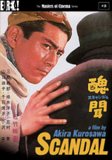![Drunken Angel [1948]](/pictures/1010992.jpg) Drunken Angel | DVD | (25/07/2005)
from £18.75
| Saving you £1.24 (6.61%)
| RRP
Drunken Angel | DVD | (25/07/2005)
from £18.75
| Saving you £1.24 (6.61%)
| RRP Post-war Japan anatomised in the combative relationship between an alcoholic doctor (Takeshi Shimura) and his patient (Toshiro Mifune) a wounded young gangster. This is the film that was considered to be Kurosawa's breakthrough movie illuminating themes that would go on to dominate his succeeding work. 'Drunken Angel' also marked his first - of many - collaborations with Toshiro Mifune here playing the tubercular Yakuza hoodlum.
![Sanjuro [1962]](/pictures/1002186.jpg) Sanjuro | DVD | (06/10/2003)
from £12.99
| Saving you £7.00 (53.89%)
| RRP
Sanjuro | DVD | (06/10/2003)
from £12.99
| Saving you £7.00 (53.89%)
| RRP Sequel to Kurosawa's own 'Yojimbo' in which the crafty samurai helps a young man and his fellow clansmen save his uncle who has been framed and imprisoned by a corrupt superintendent...
 Scandal | DVD | (14/11/2005)
from £5.54
| Saving you £14.45 (72.30%)
| RRP
Scandal | DVD | (14/11/2005)
from £5.54
| Saving you £14.45 (72.30%)
| RRP On holiday in the snow-covered mountains young painter Ichiro Aoye (Toshiro Mifune) has a chance meeting with the popular singer Miyako Saijo (Shirley Yamaguchi). After giving her a ride back to the hotel where they are both staying Ichiro is photographed with Miyako by paparazzi. A magazine creates an expos of their 'secret romance' based around this photograph and the brooding Ichiro ignites a bitter and dirty libel case in order to restore their honour... Akira Kurosawa's
![The Life Of Oharu [1952]](/pictures/1011920.jpg) The Life Of Oharu | DVD | (26/04/2004)
from £N/A
| Saving you £N/A (N/A%)
| RRP
The Life Of Oharu | DVD | (26/04/2004)
from £N/A
| Saving you £N/A (N/A%)
| RRP Mizoguchi reckoned The Life of Oharu was his masterpiece, and who are we to disagree? Certainly it's among his most perfectly structured films, in which anger at the treatment of women in Japanese society is balanced by the director's flawless sense of period, and by expert pacing and visual composition. The story is set in the 17th century, when Japan had settled into a rigidly hierarchical society. Kinuyo Tanaka, in perhaps the finest role of her career, plays Oharu, a highborn woman of the Imperial court. Disgraced when she falls in love with a man of a lower class (Toshiro Mifune, in his only film for Mizoguchi), she's made the mistress of a feudal lord. After bearing him a son she's cast out, and gradually sinks into prostitution and penury. The inevitability of Oharu's fate is tempered by her resilience of spirit--and by the compassion of Mizoguchi's gaze. Although the story is set in the past, he fully intends parallels with modern-day Japan; just after completing the film, he told an interviewer, "Comparing today with [earlier] periods, I don't find much difference: women have always been treated like slaves." The Life of Oharu was shown at the 1952 Venice Festival, where it was awarded the Golden Lion. It brought Mizoguchi a belated international fame just four years before his death, and initiated the run of late masterpieces that rounded off his career. --Philip Kemp
![Sansho Dayu [Masters of Cinema] (Dual Format Edition) [Blu-ray]](/pictures/1113980.jpg) Sansho Dayu | Blu Ray | (23/04/2012)
from £N/A
| Saving you £N/A (N/A%)
| RRP
Sansho Dayu | Blu Ray | (23/04/2012)
from £N/A
| Saving you £N/A (N/A%)
| RRP Based on an ancient legend, as recounted by celebrated author Mori Ogai (in his short story of the same name, written in 1915), and adapted by Mizoguchi, Sansho Dayu [Sansho the Steward, aka Sansho the Bailiff] is both distinctively Japanese and as deeply affecting as a Greek tragedy. Described in its opening title as one of the oldest and most tragic in Japan's history, Mizoguchi depicts an unforgettably sad story of social injustice, family love, and personal sacrifice - all conveyed with exquisite tone and purity of emotion. Set in Heian era (11th century) Japan, it follows an aristocratic woman, Tamaki (played by Tanaka Kinuyo, who also stars in Mizoguchi's Ugetsu Monogatari), and her two children, Zushio (Hanayagi Yoshiaki) and Anju (Kagawa Kyoko), who are separated by feudal tyranny from Tamaki's husband. When the children are kidnapped and sold into slavery to the eponymous Sansho (Shindo Eitaro), the lives of each of the family members follow very different paths - each course uniquely, and insufferably, tragic. Famed for its period reconstructions and powerful imagery, often through the director's trademark long takes, Sansho Dayu is one of the most critically revered of all of japanese cinema - a Venice Film Festival Silver Lion winner that often appears in lists of the greatest films ever made.

Please wait. Loading...
This site uses cookies.
More details in our privacy policy